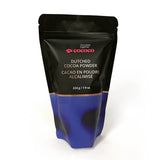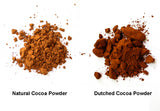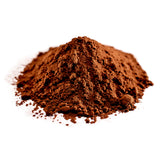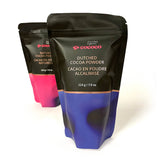Dutch-process Cocoa Powder, 224g
224 g / 8 oz
---
At Cococo, we sell a range of chocolate products, including packages of Dutch-process cocoa powder 224g. Unsure of how this option differs from Natural Cocoa Powder? Dutch-process (or "Dutched") cocoa powder involves adding potassium carbonate to neutralize cocoa's natural acidity and improve its blending properties with liquids. It gives the cocoa a darker hue, and a more mellow, woodsy flavour profile. Here's a link to our Natural Cocoa Powder if you'd like to try a simpler, more natural cocoa powder.
Our new packaging with a zip closure reduces mess and preserves freshness, making it possible for you to use your Dutch-process cocoa powder, 224g, for as long as possible. Buying quality ingredients, such as those sold by Cococo, ensures your baked goods taste incredibly delicious. If you need some baking inspiration, check out our recipe blog to view a range of delicious options, ranging from chewy brownies to protein-packed chocolate peanut butter smoothies! Contact us if you need help finding a specific product or have questions about our Dutch-process cocoa powder. You’ll reach our support team by emailing CustomerService@CococoInc.com or calling 1 (800) 661-8367.
What's the difference between Dutched Cocoa and Natural Cocoa? Read our blog.
---
Ingredients: Cocoa, potassium carbonate.
-----
This product is manufactured in a facility that handles allergens. Although we strive to hold the highest food safety and allergen control standards, the risk of cross-contamination is still present. ANY OF OUR PRODUCTS MAY CONTAIN: Milk • Soy • Eggs • Peanuts • Wheat • Barley • Almonds • Chestnuts • Hazelnuts • Pecans • Pistachios • Walnuts. For more information, please read our Allergens and Food Sensitivity information for all of our chocolate products.
- Our products are manufactured in a facility that handles allergens.
- Although we strive to hold the highest food safety and allergen control standards, the risk of cross-contamination is still present.
- Any of our products may contain: Milk • Soy • Eggs • Peanuts • Wheat • Barley • Almonds • Chestnuts • Hazelnuts • Pecans • Pistachios • Walnuts.
We make all of our confections in our Calgary chocolate factory using common equipment. We do not currently guarantee that any particular product is 100% nut-free, soy-free, gluten-free, or milk-free, even if an allergen is not actually part of the product’s recipe.
Even though we follow strict food safety protocols and clean our equipment daily, it's better to be safe than sorry. If you have a serious allergy or intolerance to one of these we suggest that you not consume our products (sorry about that).
The "may contain" statement that you will see on all of our product packaging and on our website's product pages is a statement that is considered precautionary and voluntary as a regulatory matter. We choose to include the "may contain" statements because we want to be transparent and make our customers aware of the risk of cross-contamination in our small factory, event though we try our best to control against that risk.
Please download our Allergens Information document for a complete list of all of our products and associated allergens. We invite you to contact us at CustomerService@Cococoinc.com if you have any questions.
Please read our blog if you have questions about cadmium and lead in chocolate.
________________________________________________

Q: Is milk an ingredient in dark chocolate?
A: Most no, but in a food-safety way, yes.
Our team at Cococo takes food safety—including allergen controls—very seriously. Labels are important to us.
Recently, one of our suppliers changed its dark chocolate labelling practices, and we have received our first shipment affected by the change. On the supplier’s dark chocolate labels, the change has resulted in milk no longer appearing within the precautionary statement, as had formerly been true (e.g. “May contain: Milk”). Instead, milk now appears on the label within the ingredients listing itself (e.g. “Contains: Milk”).
What does this mean? Are we telling you that milk is an ingredient in dark chocolate? Well, mostly no, meaning that milk is obviously not an intended ingredient of our proprietary dark chocolate recipes – but also in a food-safety way, yes, and here’s why.
In the world of chocolate confectionery, the same specialized equipment is sometimes used to process both milk and dark chocolate. Because of this simple fact, even if good manufacturing practices (GMPs) are followed, there may inevitably be residues of milk protein within such equipment. These residues can later come into contact with chocolate that is otherwise exclusively “dark chocolate”. No amount of cleaning can totally eliminate this concern, and the resulting trace residues of milk ingredients can only be detected in “parts per million” (ppm). Here is what our supplier wrote to us about the topic:
… the level of milk residue present due to unavoidable cross-contact can vary. As a result, these products are not suitable for “dairy free,” or “vegan” claims, and should be labeled to indicate the likely presence of milk. Because food safety is our top priority, to protect consumers . . . we have decided to change our labels to reflect the low presence of milk in the product . . . Currently, there are no U.S. regulations on setting specific limits on the amount of allergenic material that can be present in food due to cross-contact when good manufacturing practices are followed.
At Cococo, we do not make claims about our products being “dairy free” or “certified vegan”, or otherwise totally free of any particular allergen (e.g. we are not “peanut free”). Instead, because we handle various allergens in our facility, we have always asked our customers to be extra-cautious. Most of our mixed products—for example, our boxes of chocolates—already identify milk ingredients on the labels, because milk chocolate is included in these assortments. However, we also sell products labelled as “dark chocolate” (for example, a solid “dark chocolate bar”), and so here is where the change comes in:
Just like other leading chocolate companies in the world, we will now be updating our packaging to identify milk as an ingredient in otherwise solid dark chocolate. We are doing this only to reflect an underlying trace-level ppm uncertainty that we cannot totally eliminate from our processes, despite good manufacturing practices. This labelling change does not signify any purposeful inclusion of milk ingredients in our solid dark chocolate recipes.
It can take a while for new labels to replace old labels in the marketplace. As we move forward, therefore, consumers should be aware that any of our products labelled or described as containing “dark chocolate” contain traces of milk—at the levels and for the reasons described above. Stated another way, where our solid dark chocolate is concerned, the words may contain milk ingredients should be interpreted as meaning contains milk ingredients. The better approach is always the food-safe approach.
Lastly, even though we do not label our products as being “certified vegan”, and even though we are now making labelling changes in alignment with our supplier’s statement quoted above, customers may still sensibly decide for themselves that our dark chocolate products make sense within a vegan friendly diet. For customers making the choice to consume products that do not purposefully include milk as an ingredient, we ourselves believe that our “Vegan Friendly” products may continue to be a good option.
Frequently Asked Questions
Q: Do you add milk to your dark chocolate?
A: No, we do not purposefully include milk as an ingredient in our dark chocolate.
Q: Then why is there milk listed in the ingredients on solid dark chocolate vegan-friendly chocolate products?
A: Due labelling changes on the part of our chocolate supplier and due to our own handling of other products that contain milk in our facility and on shared equipment, we cannot fully eliminate all traces of milk from our dark chocolates. Therefore, we are choosing to be extra cautious and adding milk onto the ingredients list to keep our customers safe.
Q: Are you the only chocolate company doing this?
A: No. Leaders in the industry (including some of our suppliers) are following this practice.
Q: I prefer to purchase chocolates that fit into my vegan-friendly lifestyle, can I still consume your dark chocolate products?
A: Customers may still sensibly decide for themselves that our dark chocolate products make sense within a vegan-friendly diet. We believe that our “vegan-friendly” products may continue to be a good option.
Still have questions? Please contact our Customer Service for more information. 1.800.661.8367 or email us at CustomerService@Cococoinc.com
If you have received a custom-packed Copper Box as a gift - lucky you!
Since this is a custom gift and not a specific product or collection that we sell in retail, it could contain various chocolates containing a variety of ingredients. Please download our Chocolate Map for specific information on the chocolates you might find in your Copper Box.
Any of the following ingredients could be present in this custom product, including multiple allergens:
Ingredients: Milk chocolate (sugar, cocoa butter*, whole milk powder, cocoa mass*, sunflower lecithin, natural vanilla flavouring) • Semi-sweet chocolate (unsweetened chocolate*, sugar, cocoa butter*, sunflower lecithin, milk) • White chocolate (sugar, cocoa butter*, whole milk powder, sunflower lecithin, natural vanilla flavouring) • Sugars (invert sugar, glucose, organic cane sugar, fondant (sugar, glucose syrup), golden yellow sugar, icing sugar (sugar, corn starch), apricot puree, mango puree, passion fruit juice, raspberry puree, strawberry puree, black currant puree, pumpkin puree, marionberry puree, cherry puree, molasses, granulated sugar) • Butter • Cream • Ruby chocolate (sugar, cocoa butter, nonfat dry milk, whole milk powder, unsweetened chocolate, soy lecithin, citric acid, natural vanilla flavour) • Bitter-sweet chocolate (unsweetened chocolate, sugar, cocoa butter, sunflower lecithin, natural vanilla flavour, milk) • Liqueurs (rum, rye whiskey, crème de cassis, grand marnier, advocaat, crème de cacao, maple whiskey, kahlua, irish cream liqueur, pernod, honey liqueur, cognac, apricot brandy liqueur, benedictine, hot cinnamon schnapps, crème de menthe, cointreau, black sambuca) • Amaretto flavour • Maraschino flavour • Mandarin orange flavour • Orange flavour oil • Pear williams • Natural black cherry extract • Espresso coffee extract • Irish cream extract • Peppermint extract • Almond extract • Café extra • Mexican cinnamon oil extract • Hazelnuts • Walnuts • Almonds • Pistachios • Pecans • Sweetened hazelnut paste (hazelnuts, sugar, soy lecithin) • Hazelnut paste • Natural peanut butter • Candied ginger (ginger, cane sugar) • Candied orange peel (orange peel, sugar cane, rice glucose syrup) • Coconut • Graham wafer crumbs (wheat flour, whole grain wheat flour, sugar, vegetable oil, salt, baking soda, ammonium bicarbonate, monocalcium phosphate, soy lecithin, asparaginase, artificial flavour) • Honey • Coconut milk (organic coconut base, organic cane sugar, organic guar gum, xanthan gum) • Sweetened condensed milk • Oat milk (oat base, sunflower oil, vitamins and minerals, dipotassium phosphate, sea salt, locust bean gum, gellan gum, natural flavour, amylase, ascorbic acid) • Maple syrup • Cocoa butter* • Egg white • Egg albumen (egg white, citric acid, baker’s yeast) • Pectin • Organic coconut oil • Cocoa powder* • Vanilla bourbon paste (cane sugar, water, madagascar vanilla extract, vanilla bean seeds, gum tragacanth) • Pomegranate-quince white balsamic vinegar • Coffee beans • Water • Coloured cocoa butter (ultra refined cocoa butter, brilliant blue, indigotine, tartrazine, sunset yellow fcf, allura red, titanium dioxide) • Cocoa powder (cocoa, potassium carbonate) • Lemon juice • Lavender • Sunflower lecithin • Sea salt • Citric acid • Spices (star anise, ground cinnamon, ground nutmeg, ground cloves, ground ginger, pink peppercorns) • Earl grey tea • Mint • Baking soda • Colours (iron oxide, rice starch, spirulina extract, turmeric, anthocyanins). Contains: Milk • Soy • Eggs • Peanuts • Almonds • Hazelnuts • Pecans • Pistachios • Walnuts. May Contain: Wheat • Barley.
Storing Chocolates
Why should I care about how I store my chocolates?
Many of our filled chocolate bonbons are perishable because we make them with fresh dairy, simple ingredients, and no artificial preservatives. Plus, we use our own proprietary couverture chocolate with a high cocoa butter content which means our chocolate starts to soften at about 22 C. If allowed to get too warm, your delicious little chocolates will melt into a gooey mass, and you will have to scrape it out of the box and spoon directly into your mouth (but maybe that’s okay with you — we’re not here to judge).
Copper Boxes of Assorted Chocolates
The chocolates found in our Copper Boxes and from our Chocolate Case are best enjoyed fresh, soon after purchasing. Should storage be required, they can be stored in a sealed plastic bag or container in a cool, dry place not above 20-22C / 68-70F for up to 14 days and away from strong odours (chocolate absorbs odours easily). Please refrigerate to maintain freshness and please enjoy within 14 days of purchase. Allow to warm at room temperature for about 20 minutes before enjoying (you'll thank us later). If longer storage is required, you can freeze your chocolates — read below for instructions "Freezing Chocolates".
Chocolate Collections
Please refrigerate (in a sealed container or bag in your refrigerator is best — for up to 14 days and away from strong odours) to maintain freshness and please enjoy within 14 days. Allow to warm at room temperature for about 20 minutes before enjoying so that the full flavours of the bonbon can emerge. If longer storage is required, you can freeze your chocolates — read below for instructions.
Advent Calendars:
Our Advent Calendars are full of award-winning chocolates that all have a durable life date (shelf life) of minimum 2 months.
- For long storage (more than 2 weeks before December 1) use the Freezer: You can store your Advent Calendar in sealed plastic bag in your freezer for up to 6 months. In a 2-step process, let thaw in the refrigerator for 24 hours in the sealed plastic bag before enjoying on December 1. Thawing slowly in the sealed plastic bag in the fridge helps prevent moisture damage called Chocolate Bloom.
- For short storage (less than 2 weeks before December 1) use the Fridge: Place Advent Calendar in sealed plastic bag in the fridge before removing and enjoying on December 1. Allow your first chocolate to come to room temperature for 20 minutes for the full flavours to emerge.
Solid Chocolates - bars, shavings, molded items
Store solid chocolate - like bars, shavings, chocolate drops, molded items, chocolate Yule log shells, and chocolate Easter Egg shells - in a cool dry location for up to 12 months. You can also put it in a sealed freezer-safe bag and freeze for up to a year or more. Solid chocolate is very stable. If you notice greyish or whitish streaks on your chocolate, it could be Chocolate Bloom, which is perfectly fine.
Our Recipes blog has many excellent ways to use up any extra chocolate!
Chocolate Bloom
If your solid chocolate looks scuffed, or streaky, or has mottled whitish marks on the surface, then that is evidence of something called "chocolate bloom". Chocolate bloom is one of two types: fat bloom, caused by changes in the fat crystals in the chocolate; and sugar bloom, due to crystals formed by the action of moisture on the sugar. Chocolate that has "bloomed" is still safe to eat, though it might look a bit odd. Go ahead and enjoy it!
Freezing Chocolates
Did you know you can freeze your chocolates? It's true!
Filled Chocolates (bonbons):
Simply pack bonbons in an airtight bag or container and place in the freezer for up to 6 months or a bit longer. Thawing them properly is important. In a two stage process (which will help maintain the quality of your product)
- in a sealed bag or container, thaw the selected chocolates in the fridge overnight, and then
- allow chocolates to warm to room temperature for 20 minutes, before enjoying.
To fully experience its flavour and texture, our chocolates are best enjoyed at room temperature. If stored in a cool place, like a fridge, we recommend placing your chocolates at room temperature at least 20 minutes prior to enjoying (you’ll thank us later).
Solid Chocolates - bars, shavings, molded items:
If you'd like, chop bars or molded items (including Santas, Easter Bunnies, chocolate Yule log shells, and chocolate Easter Egg shells) into small pieces to make storage easier. You might like to store specific small quantities in bags to make them convenient grab-and-go portions when you need 1 cup of chocolate for a recipe. To thaw, palace the selected solid chocolate pieces in the fridge for 1-2 hours, and then to room temperature for baking or melting.
Our Recipes blog has many excellent ways to use up any extra chocolate!








